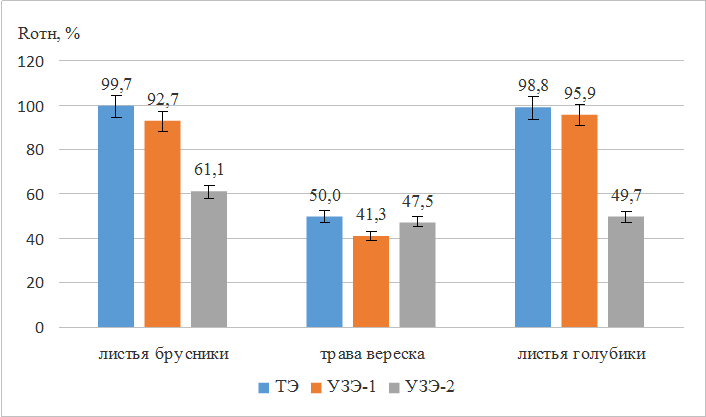COMPARATIVE CHARACTERISTICS OF SOME PLANTS FAMILY HEATHER EXTRACTS AND THE EFFECTIVENESS OF METHODS FOR THEIR PRODUCTION
UDC 582.912.46:582.912.48: 543.42
Abstract
The paper presents new data related to the comparative study of water-alcohol leaf extracts of the heather plants family (highbush blueberry, lingonberry, heather). Leaf extracts were obtained by three methods, two of which were using ultrasonic emitters (an ultrasound bath and a submersible ultrasonic probe), the third method, thermal (traditional), was chosen as a comparison. The extracts are characterized by parameters as the total content of extractive substances, the sum of phenolic compounds, flavonoids, the dispersed phase size particles distribution determined by the method of dynamic light scattering, and a quantitative assessment of the integral antioxidant activity is given. It has been established that ultrasonic probing has a highest activity in extracting phenolic compounds and flavonoids from lingonberry leaves and heather grass, and at the same time the level of their antioxidant activity is inferior to the extracts obtained by the traditional method at which the plant raw materials is boiled with the extractant. The traditional thermal method is characterized by the highest values of the sum of extractives for all types of raw materials and average values for the sum of phenolic compounds and flavonoids. There are observed a significant increase in the content of particles with the size <1000 nm for "ultrasonic" lingonberry leaf extracts is compared to the traditional method, however this pattern is not fulfilled for other types of raw materials. All heather herb extracts have a high polydispersity and the greatest tendency to sediment formation during the storage.
Downloads
Metrics
References
Azwanida N.N. Med. Aromat. Plants, 2015, vol. 4, 196. DOI: 10.4172/2167-0412.1000196.
Danlami J.M., Arsad A., Zaini M.A.A., Sulaiman H. Rev. Chem. Eng., 2014, vol. 30(6), pp. 605–626. DOI: 10.1515/revce-2013-0038.
İnce A.E., Şahin S., Şümnü S.G. Turkish Journal of Agriculture and Forestry, 2013, vol. 37, pp. 69–75. DOI: 10.3906/tar-1201-1.
Han H., Wang S., Rakita M., Wang Y., Han Q., Xu Q. Food and Nutrition Sciences, 2018, vol. 9, pp. 1034–1045. DOI: 10.4236/fns.2018.98076.
Jovanović A.A., Đorđević V.B., Zdunić G.M., Pljevljakušić D.S., Šavikin K.P., Gođevac D.M., Bugarski B.M. Sep. Purif. Technol., 2017, vol. 179, pp. 369–380. DOI: 10.1016/j.seppur.2017.01.055.
Bremner D., Burgess A., Chand R. Current Organic Chemistry, 2011, vol. 15, pp. 168–177. DOI: 10.2174/138527211793979862.
Ma Y.-Q., Ye X.-Q., Fang Z.-X., Chen J.-C., Xu G.-H., Liu D.-H. Journal of Agricultural and Food Chemistry, 2008, vol. 56 (14), pp. 5682–5690. DOI: 10.1021/jf072474o.
Setyaningsih W., Saputro I.E., Palma M., Barroso C.G. AIP Conf. Proc., 2016, vol. 1755, 080009. DOI: 10.1063/1.4958517.
Patil S., Torres B., Tiwari B.K., Wijngaard H.H., Bourke P., Cullen P.J., O’Donnell C.P., Valdramidis V.P. J. Food Sci., 2010, vol. 75, pp. 437–443. DOI: 10.1111/j.1750-3841.2010.01750.x.
Sun Y., Qiao L., Ye X., Liu D., Zhang X., Huang H. Molecules, 2013, vol. 18(1), pp. 561–573. DOI: 10.3390/molecules18010561.
Jamal M., Amir M., Ali Z., Mujeeb M. Future Journal of Pharmaceutical Sciences, 2018, vol. 4 (2), pp. 229–233. DOI: 10.1016/j.fjps.2018.07.002.
Traversier M., Gaslonde T., Lecso M., Michel S., Delannay E. International Journal of Cosmetic Science, 2020, vol. 42, pp. 127–135. DOI: 10.1111/ics.12595.
Ferlemi A.-V., Lamari F.N. Antioxidants, 2016, vol. 5, no. 2, p. 17. DOI: 10.3390/antiox5020017.
Zaprometov M.N. Osnovy biokhimii fenol'nykh soyedineniy. [Fundamentals of biochemistry of phenolic compounds]. Moscow, 1974, 214 p. (in Russ.).
Lee L.S., Lee N., Kim Y.H., Lee C.H., Hong S.P., Jeon Y.W., Kim Y.E. Molecules, 2013, vol. 18(11), pp. 13530–13545. DOI: 10.3390/molecules181113530.
Gosudarstvennaya farmakopeya RF. XIV izd. [State Pharmacopoeia of the Russian Federation. XIV ed.]. Moscow, 2018. URL: http://femb.ru/femb/pharmacopea.php. (in Russ.).
Patent 2475724 (RU). 20.02.2013. (in Russ.).
Shpigun L.K., Zamyatina N.N., Shushenachev Ya.V., Kamilova P.M. Zhurnal analiticheskoy khimii, 2012, vol. 67, no. 10, pp. 893–901. (in Russ.).
Huie C.W. Anal. Bioanal. Chem., 2002, vol. 373, pp. 23–30. DOI: 10.1007/s00216-002-1265-3.
Tarun Ye.I., Khrapovitskaya A.V., Shidlovskaya Ye.Yu., Kurchenko V.P. Ekologicheskiy vestnik, 2016, no. 1, pp. 35–39. (in Russ.).
Lazarev A.S., Klyauzova A.V., Ruchkina A.G., Kobrakov K.I., Shpigun L.K. Khimiya rastitel'nogo syr'ya, 2019, no. 4, pp. 223–232. DOI: 10.14258/jcprm.2019045498. (in Russ.).
Dai J., Mumper R.J. Molecules, 2010, vol. 15, pp. 7313–7352.
Solomatin A.A, Khaziyev R.Sh., Makarova A.S., Ivanova S.A. Teoreticheskiye osnovy khimicheskoy tekhnologii, 2015, vol. 49, no. 2, pp. 206–212. (in Russ.).
Bremner D., Burgess A. Chand R. Curr. Org. Chem., 2011, vol. 15, pp. 168–177.

Copyright (c) 2022 chemistry of plant raw material

This work is licensed under a Creative Commons Attribution 4.0 International License.

This work is licensed under a Creative Commons Attribution 4.0 International License.
The authors, which are published in this journal, agree to the following conditions:
1. Authors retain the copyright to the work and transfer to the journal the right of the first publication along with the work, at the same time licensing it under the terms of the Creative Commons Attribution License, which allows others to distribute this work with the obligatory indication of the authorship of this work and a link to the original publication in this journal .
2. The authors retain the right to enter into separate, additional contractual agreements for the non-exclusive distribution of the version of the work published by this journal (for example, to place it in the university depository or to publish it in a book), with reference to the original publication in this journal.
3. Authors are allowed to post their work on the Internet (for example, in a university repository or on their personal website) before and during the review process of this journal, as this may lead to a productive discussion, as well as more links to this published work.











